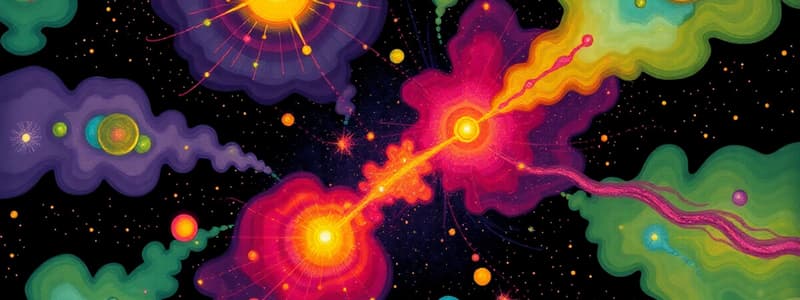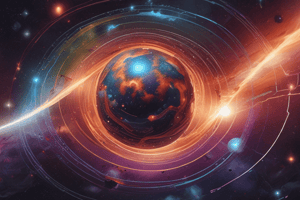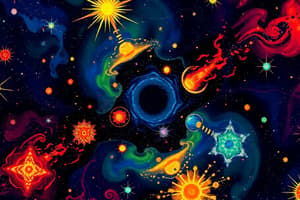Podcast
Questions and Answers
What happens when the inner parts of a gas cloud become too dense?
What happens when the inner parts of a gas cloud become too dense?
- Photons can escape, causing temperature to drop.
- The cloud stops collapsing entirely.
- The gas cloud begins to expand outward.
- Photons can no longer escape, leading to a rise in temperature. (correct)
What is characteristic of emission nebulae?
What is characteristic of emission nebulae?
- They are regions lit up by young hot stars. (correct)
- They are devoid of any gas or dust.
- They are formed by cold molecular clouds only.
- They primarily consist of rocky minerals and metals.
How does the collapse of a gas cloud affect temperature?
How does the collapse of a gas cloud affect temperature?
- Temperature decreases as density increases.
- Squeezing gas causes it to heat up. (correct)
- Temperature remains constant during the collapse.
- Temperature increases with expansion.
At what core temperature does nuclear fusion begin in a star?
At what core temperature does nuclear fusion begin in a star?
What is meant by hydrostatic equilibrium in stars?
What is meant by hydrostatic equilibrium in stars?
What do protoplanetary discs form from?
What do protoplanetary discs form from?
How do young hot stars influence their surroundings?
How do young hot stars influence their surroundings?
What creates a 'naked' protostar?
What creates a 'naked' protostar?
What is the primary composition of the Sun's core?
What is the primary composition of the Sun's core?
What happens to the temperature and pressure during the collapse of a gas cloud?
What happens to the temperature and pressure during the collapse of a gas cloud?
What is the significance of accretion disks in the process of star formation?
What is the significance of accretion disks in the process of star formation?
What characterizes the color pink in emission nebulae?
What characterizes the color pink in emission nebulae?
What is the effect of strong solar winds on surrounding material in young stars?
What is the effect of strong solar winds on surrounding material in young stars?
What defines protostar jets?
What defines protostar jets?
What role does rotation play in the formation of a star?
What role does rotation play in the formation of a star?
Why do outer parts of a collapsing gas cloud remain cool and low in density?
Why do outer parts of a collapsing gas cloud remain cool and low in density?
What is the primary gas found in molecular clouds?
What is the primary gas found in molecular clouds?
How does the temperature of a protostar change over time?
How does the temperature of a protostar change over time?
What are solar flares and how have they changed over time?
What are solar flares and how have they changed over time?
What distinguishes a star from a planet?
What distinguishes a star from a planet?
What effect does heating have on the gas surrounding a young star?
What effect does heating have on the gas surrounding a young star?
What conditions are necessary for the formation of a protostar?
What conditions are necessary for the formation of a protostar?
What characterizes the color of emission nebulae?
What characterizes the color of emission nebulae?
What is the primary factor influencing how a star evolves?
What is the primary factor influencing how a star evolves?
Flashcards are hidden until you start studying
Study Notes
Star Birth
- Stars begin their life in immense clouds of gas and dust called molecular clouds, primarily composed of hydrogen.
- These clouds are cold, dark, and incredibly dense, offering the ideal conditions for star formation.
- Collapse within a molecular cloud is triggered by external factors, such as the shockwave from a nearby supernova, leading to the formation of protostars.
- As a cloud collapses, its inner parts become more dense and hotter due to collisions between molecules.
- Rising temperature and pressure slow the collapse, but the core continues to heat up eventually reaching 1 million degrees Celsius.
- At this temperature, photons emitted from the compressed core can no longer escape, leading to a rapid increase in temperature and pressure.
- As the core heats up, it eventually reaches a staggering 10 million degrees Celsius, the temperature needed for nuclear fusion to begin.
- Nuclear fusion marks the birth of a star, as hydrogen atoms fuse together to form helium, releasing tremendous energy and light.
- The outward pressure from the nuclear fusion balances the inward pull of gravity, creating a state of hydrostatic equilibrium which allows a star to remain stable.
Protostar Formation
- The central region of a collapsing cloud forms a protostar, a hot, dense core surrounded by a thick envelope of gas known as a protoplanetary disk.
- The disk acts like a reservoir, gathering additional material from the surrounding cloud and supplying fuel for the growing protostar.
- The protostar continues to grow as it pulls more material from the disc, increasing its mass and luminosity.
- Jets, powerful streams of gas expelled from the protostar's poles, clear a path, pushing away the surrounding gas.
- These jets play a crucial role in shaping the young star and its surrounding environment.
The Evolution of a Protostar
- As a protostar evolves, its temperature and density increase, and its luminosity also rises.
- Eventually, a naked protostar is revealed as the winds and jets blow away most of the surrounding gas, leaving the protostar exposed.
- The protostar's surrounding environment becomes hot and bright, leading to the formation of emission nebulae, glowing regions lit up by newly formed stars.
- These nebulae offer a visible testament to the ongoing process of star formation.
- The protoplanetary disk continues to evolve, allowing for planetary formation.
- Planets form within the disc by accretion, gradually gathering material from the surrounding environment.
The Role of Rotation
- Rotation plays a crucial role in star formation.
- The collapsing gas cloud spins faster as it conserves angular momentum.
- This spinning cloud eventually forms an accretion disk, a flat, rotating disk of material that feeds the growing protostar.
- The accretion disk is crucial for guiding material towards the protostar, facilitating the formation of jets.
The Sun’s Formation
- Our Sun formed from a vast cloud of gas and dust approximately 4.6 billion years ago.
- It originally rotated at a much faster rate than today, completing a revolution in one week.
- The Sun's spin rate has since slowed to one month, a testament to the process of star formation and evolution.
The Nature of Stars
- The vast majority of stars exist in pairs, with over 85% of stars in binary systems.
- The interactions between two stars can significantly affect their evolution.
- The presence of a companion star can influence a star's life span and movement.
Galaxy Formation
- Galaxies are vast systems of stars, gas, dust, and dark matter, held together by gravity.
- Typically, galaxies have a clear structure, with a central bulge, a disk, and rotating spiral arms.
- They are often home to molecular clouds, emission nebulae, young stars, and older stars.
- These components are tightly interwoven, interacting and shaping the galaxy's overall structure and evolution.
Studying That Suits You
Use AI to generate personalized quizzes and flashcards to suit your learning preferences.




